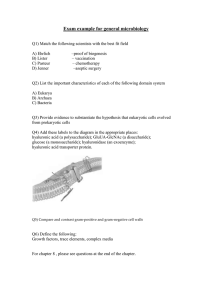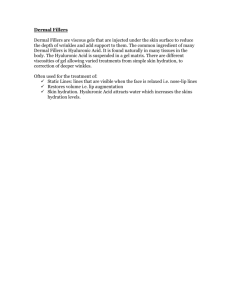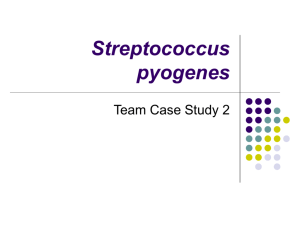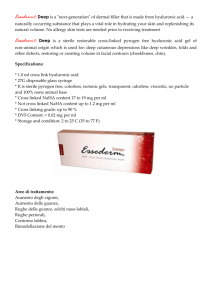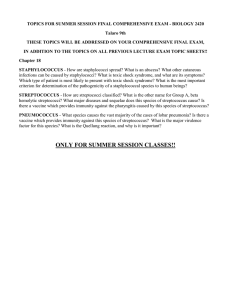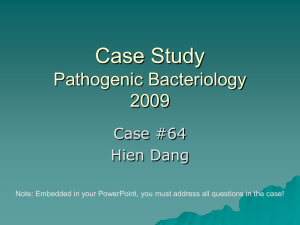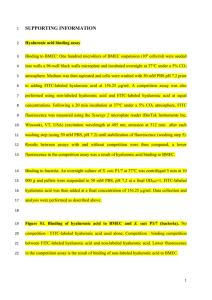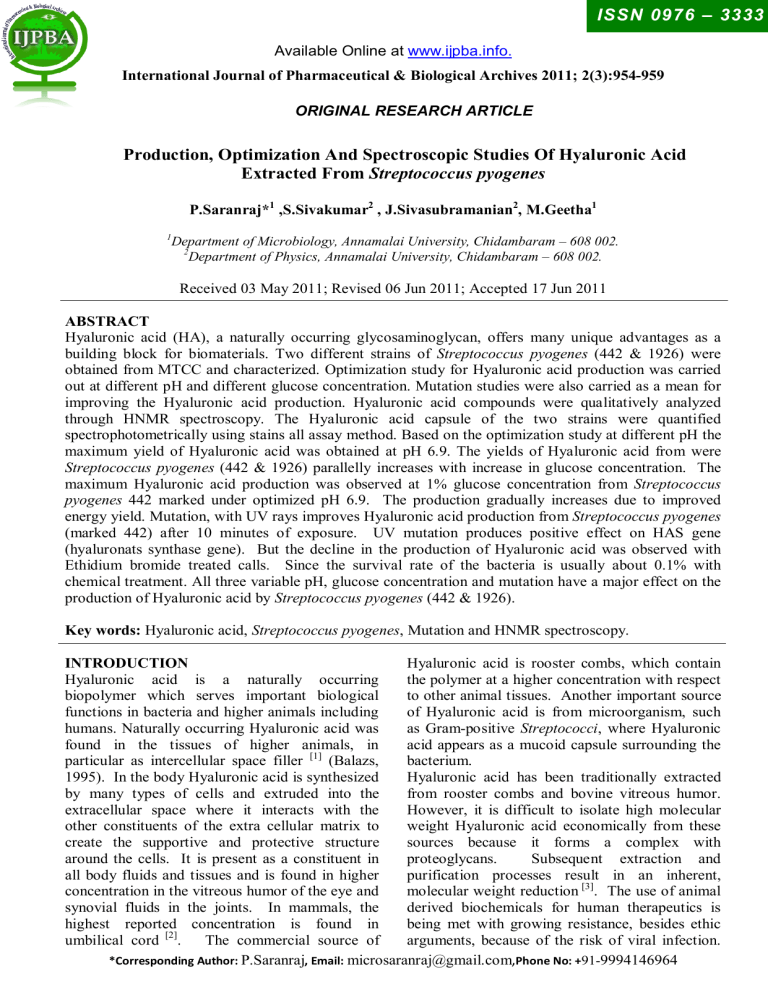
ISSN 0976 – 3333
Available Online at www.ijpba.info.
International Journal of Pharmaceutical & Biological Archives 2011; 2(3):954-959
ORIGINAL RESEARCH ARTICLE
Production, Optimization And Spectroscopic Studies Of Hyaluronic Acid
Extracted From Streptococcus pyogenes
P.Saranraj*1 ,S.Sivakumar2 , J.Sivasubramanian2, M.Geetha1
1
Department of Microbiology, Annamalai University, Chidambaram – 608 002.
2
Department of Physics, Annamalai University, Chidambaram – 608 002.
Received 03 May 2011; Revised 06 Jun 2011; Accepted 17 Jun 2011
ABSTRACT
Hyaluronic acid (HA), a naturally occurring glycosaminoglycan, offers many unique advantages as a
building block for biomaterials. Two different strains of Streptococcus pyogenes (442 & 1926) were
obtained from MTCC and characterized. Optimization study for Hyaluronic acid production was carried
out at different pH and different glucose concentration. Mutation studies were also carried as a mean for
improving the Hyaluronic acid production. Hyaluronic acid compounds were qualitatively analyzed
through HNMR spectroscopy. The Hyaluronic acid capsule of the two strains were quantified
spectrophotometrically using stains all assay method. Based on the optimization study at different pH the
maximum yield of Hyaluronic acid was obtained at pH 6.9. The yields of Hyaluronic acid from were
Streptococcus pyogenes (442 & 1926) parallelly increases with increase in glucose concentration. The
maximum Hyaluronic acid production was observed at 1% glucose concentration from Streptococcus
pyogenes 442 marked under optimized pH 6.9. The production gradually increases due to improved
energy yield. Mutation, with UV rays improves Hyaluronic acid production from Streptococcus pyogenes
(marked 442) after 10 minutes of exposure. UV mutation produces positive effect on HAS gene
(hyaluronats synthase gene). But the decline in the production of Hyaluronic acid was observed with
Ethidium bromide treated calls. Since the survival rate of the bacteria is usually about 0.1% with
chemical treatment. All three variable pH, glucose concentration and mutation have a major effect on the
production of Hyaluronic acid by Streptococcus pyogenes (442 & 1926).
Key words: Hyaluronic acid, Streptococcus pyogenes, Mutation and HNMR spectroscopy.
Hyaluronic acid is rooster combs, which contain
INTRODUCTION
Hyaluronic acid is a naturally occurring
the polymer at a higher concentration with respect
to other animal tissues. Another important source
biopolymer which serves important biological
of Hyaluronic acid is from microorganism, such
functions in bacteria and higher animals including
humans. Naturally occurring Hyaluronic acid was
as Gram-positive Streptococci, where Hyaluronic
acid appears as a mucoid capsule surrounding the
found in the tissues of higher animals, in
[1]
(Balazs,
particular as intercellular space filler
bacterium.
1995). In the body Hyaluronic acid is synthesized
Hyaluronic acid has been traditionally extracted
by many types of cells and extruded into the
from rooster combs and bovine vitreous humor.
However, it is difficult to isolate high molecular
extracellular space where it interacts with the
other constituents of the extra cellular matrix to
weight Hyaluronic acid economically from these
sources because it forms a complex with
create the supportive and protective structure
around the cells. It is present as a constituent in
proteoglycans.
Subsequent extraction and
all body fluids and tissues and is found in higher
purification processes result in an inherent,
concentration in the vitreous humor of the eye and
molecular weight reduction [3]. The use of animal
synovial fluids in the joints. In mammals, the
derived biochemicals for human therapeutics is
being met with growing resistance, besides ethic
highest reported concentration is found in
[2]
umbilical cord .
The commercial source of
arguments, because of the risk of viral infection.
*Corresponding Author: P.Saranraj, Email: microsaranraj@gmail.com,Phone No: +91-9994146964
IJPBA, May - Jun, 2011, Vol. 2, Issue, 3
P.Saranraj et al. / Production, Optimization And Spectroscopic Studies Of Hyaluronic Acid Extracted From Streptococcus
pyogenes
Industries have turned to bacterial fermentation
processes with the hope of obtaining
commercially viable polymer.
In bacterial
fermentation, extracellular polysaccharide is
released in to the growth medium and control of
polymer characteristics and product yields are
feasible. The amount of biopolymer that can be
produced by this route is theoretically unlimited.
Streptococci are nutritionally fastidious anaerobes,
which produce lactic acid as a by-product of
glucose metabolism. The Hyaluronic acid capsule
is a biocompatibility factor, formed as a mucoid
capsule around the cell, which enables the gram
positive bacteria to evade host immune defenses
and hence accounts for its characteristically high
virulence level. In Streptococcus, Hyaluronic acid
is produced as a secondary metabolite and the
production is influenced by various factors that
include genetic as well as nutritional.
Streptococcus produces Hyaluronic acid both
under aerobic and anaerobic condition [4]. Certain
strains of Streptococcus produce Hyaluronic acid
at a particular stage in their life cycle and the
same organism secrete enzyme hyaluronidase at a
later time, which degrades the Hyaluronic acid
produced earlier, hence the strain selected for
Hyaluronic acid production were negative for
hyaluronidase activity and non pathogenic[5] .
Spectrophotometric method was used to estimate
the concentration of Hyaluronic acid present in the
sample. Hyaluronic acid in the sample react with
stains all reagents giving purple color. The color
developed was read at 640nm [6]. Higher
performances liquid chromatography (HPLC),
size exclusion chromatography (SEC) coupled
with multi angle laser light scattering photometry
(Malls) were the other methods used to quantify
Hyaluronic acid [7]. H1-HNMR spectroscopy was
used to qualitatively verify the Hyaluronic acid.
The samples were dissolved and the spectra were
record
using
a
Varian
Inova
500
spectrophotometer [8].
MATERIALS AND METHODS
Characterization of Streptococcus pyogenes
Two different strains of Streptococcus pyogenes
with pathogenic characters were brought from
MTCC, Chandigarh (MTCC No: 442 & 1926).
The culture purity was checked as per the
guidelines of Bergey’s manual of bacteriology.
The cultures were activated by introducing into
sterile Nutrient broth and were incubated at 37oC
with minimum shaking in Mechanical shaker.
After incubation, a loopful of culture from each
flask was transferred to separate Blood agar
plates. The plates were incubated at 37oC under
5% CO 2 atmosphere for 24 hours and observed
for the characteristic growth.
Isolation of Hyaluronic Acid producers
Hyaluronic acid producing organisms were
selected based on their hemolytic character. Best
hemolysis producing colonies were picked from
each Blood agar plates (Marked 442 & 1926) and
streaked on Todd- Hewitt agar plates. The plates
were incubated at 37oC in a 5% CO 2 atmosphere
for 24hours.
Influence of pH on the production of
Hyaluronic acid
The influence of pH on the production of
Hyaluronic acid was measured by the following
method. 10ml of production medium maintained
at five different pH (6.3, 6.6, 6.9 7.2 and 7.5) were
inoculated with loopful of Streptococcus pyogenes
(442 & 1926), and incubated at 37oC for 16hours.
Aliquots of the overnight cultures were inoculated
into 10ml of fresh production medium and
incubated at 37oC for 24hours under shaking
condition. The resulting suspensions were
centrifuged, washed with 10ml of 10mM Tris HCl
(pH 7.5) and vortexed for 10 seconds.
Influence of Glucose concentration on the
production of Hyaluronic acid
The influence of glucose concentration on the
production of Hyaluronic acid was measured by
following the method of Goh, 1994 [9]. Five
conical flasks containing 10ml of production
medium each was supplemented with different
glucose concentration (0.2, 0.4, 0.6, 0.8 and 1%)
were inoculated with 15-30 colonies of
Streptococcus pyogenes (MTCC 442 & 1926) and
incubated at 37oC for 16hours. Aliquots of the
overnight culture were sub-cultured in to 10ml of
fresh production medium and incubated at 37oC
for 24 hours under shaking condition. The
resulting suspensions were centrifuged, washed
with 10ml of 10mM Tris HCl (pH 7.5) and
vortexed for 10 seconds.
Mutation studies
Two mutagenic agents, UV radiation and
Ethidium bromide, were used to mutate
Streptococcus pyogenes (442 & 1926) as a mean
of improving the Hyaluronic Acid production.
Influence of UV Mutation on Hyaluronic Acid
production
1ml of culture Streptococcus pyogenes (442 &
1926) grown on Todd-Hewitt broth (production
media) was centrifuged and the pellet was
resuspended in 1ml of nutrition free saline
955
© 2010, IJPBA. All Rights Reserved.
IJPBA, May - Jun, 2011, Vol. 2, Issue, 3
P.Saranraj et al. / Production, Optimization And Spectroscopic Studies Of Hyaluronic Acid Extracted From Streptococcus
pyogenes
medium. Cells suspended in saline were exposed
to UV for different time intervals (5, 10, 15, 20,
25 min) UV exposed cells were streaked on Blood
agar plates. As per the selection procedure,
Hyaluronic acid producing colonies were selected
and loopful colonies of Streptococcus pyogenes
(442 & 1926) were inoculated in to the production
medium, and incubated at 37oC for 16 hours.
Aliquots of the overnight culture were subcultured in to 10ml of fresh production medium
and incubated at 37oC for 24 hours under shaking
condition.
The resulting suspensions were
centrifuged, washed with 10ml of 10mM Tris HCl
(pH 7.5) and vortexed for 10 seconds.
Influence of Ethidium Bromide on Hyaluronic
Acid production
Stock solution of Ethidium bromide (1mg/ml) was
prepared. 1ml of Streptococcus pyogenes (442 &
1926) Todd-Hewitt broth (production media) were
pelleted and resuspended in 1ml of nutrition free
saline solution, to which 1ml of Ethidium bromide
were added, from the stock, and incubated for
1hourr. Cells were streaked on Blood agar plates.
After incubation for 24 hours, white mucoid
colonies in the Blood agar plates were utilized for
Hyaluronic acid production. 10ml of production
medium was inoculated with a loopful of colonies,
and incubated at 37oC for 16 hours. Aliquots of
the overnight culture were sub-cultured into 10 ml
of fresh production medium and incubated at 37oC
for 24hours under shaking condition.
The
resulting suspensions were centrifuged, washed
with 10ml of 10mM Tris HCl (pH 7.5) and
vortexed for 10sec.
Extraction of Hyaluronic Acid
Bacterial cells cultivated under different
conditions were pelleted out and the cell pellets
were resuspended in 1.5ml of water and vortexed
for 10seconds. This washing sequence was
repeated and the cell pellets were resuspended in
water to a final volume of 1.5 ml. Hyaluronic
acid capsule was extracted by adding 1.5ml of
chloroform and vortexed for 60 seconds. Cells
remained at room temperature for 1 hour and then
were pelleted and 500µl of the aqueous phase was
used for estimation.
Quantitative estimation of Hyaluronic acid by
stains all assay
The quantitative estimation of Hyaluronic acid by
strain all assay was measured by following the
method of Gray Darmstadt et al., 1999[10]. The
aqueous phase containing Hyaluronic acids were
separated. 1ml of fresh stains all reagents were
added to each sample. After vortexing for 25
seconds, the spectrophotometric absorbance was
read immediately at 640nm. The amounts of
Hyaluronic acid capsule were determined by
interpolation from the standard graph for
Hyaluronic acid. Standards were prepared
containing 0.5, 1.0, 1.5, and 2.5, 5µg of
Hyaluronic acid (sigma), which is plotted via
stains all assay.
HNMR spectroscopy (Jennie Baier Leach et al.,
2002)
In HNMR, a molecular sample, usually dissolved
in a liquid solvent is placed in a magnetic field
and the absorption of RF waves by certain nuclei
(proton & others) is measured. This property is
utilized to assign the structural and dynamic
properties of the molecule. The samples were
dissolved in heavy water (D 2 O) tetramethylsilane
(TMS) was added as internal standard to deduce
the chemical shift of protons. The spectra were
recorded using a Varian Inova – 500
spectrophotometer.
RESULTS AND DISCUSSION
Two different strains of Streptococcus pyogenes
with pathogenic characters were brought from
MTCC; Chandigarh (MTCC No: 442 & 1926)
was characterized by preliminary tests, cultivating
on selective media and standard biochemical tests.
Based on the Conventional Biochemical tests, the
organism was characterized as Streptococcus
pyogenes. The results were shown in (Table 1).
Large white, mucoid colonies were appeared on
Todd – Hewitt agar plates. These colonies were
utilized for Hyaluronic acid production.
In Streptococcus, Hyaluronic acid is produced as a
secondary metabolite and the production is
influenced by various factors that include genetic
as well as nutritional. Streptococcus produces
Hyaluronic acid both under aerobic and anaerobic
condition [4]. Certain strains of Streptococcus
produce Hyaluronic acid at a particular stage in
their life cycle and the same organism secrete
enzyme hyaluronidase at a later time, which
degrades the Hyaluronic acid produced earlier,
Hence the strain selected for Hyaluronic acid
production were negative for hyaluronidase
activity and non pathogenic [5].
HA content of the Streptococcus pyogenes (442 &
1926) incubated at five different pH 6.3, 6.6, 6.9
7.2 and 7.5) were analyzed according to the
procedure Gray Darmstadt et al., 1999. Based on
the results obtained (Table 2) the maximum HA
yield was observed at pH 6.9 (0.69/10ml of
culture 442). Decline in the production of HA
956
© 2010, IJPBA. All Rights Reserved.
P.Saranraj et al. / Production, Optimization And Spectroscopic Studies Of Hyaluronic Acid Extracted From Streptococcus
pyogenes
were observed at pH 6.2 (0.14/10ml of culture
1926) and pH 7.5 (0.03mg/10ml of culture 442).
Production media were maintained at optimized
pH 6.9 and Hyaluronic acid production by
Streptococcus pyogenes (442 & 1926) were
estimated at five different Glucose concentrations
(0.2, 0.4, 0.6, 0.8 and 1%) according to the
procedures Gary Darmstadt et al., 1999. Based on
the results (Table 3) the Streptococcus pyogenes
(Marked 442) give maximum Hyaluronic acid
yield at 1% Glucose concentration under
optimized pH 6.9 yields gradually increases with
increase in Glucose concentration.
Table-1: Characterization of Streptococcus pyogenes
Table -2: Influence of pH on the production of
Hyaluronic acid by Streptococcus pyogenes.
IJPBA, May - Jun, 2011, Vol. 2, Issue, 3
S.N Biochemical test
1 Gram staining
2 Motility
3 Catalase test
MTCC
442
Positive
Motile
Negative
MTCC 1926
Positive
Motile
Negative
4 Growth with 6.5% NaCl
5 β – hemolysis in Blood agar
Negative
Positive
Negative
Positive
6 Hydrolysis of Hippurate
Negative
Negative
7 Bile esculin test
8 Acid from lactose
Positive
Positive
Positive
Positive
9 Bacitracin disk susceptibility
Positive
Positive
S.N pH
1.
6.3
2.
6.5
3.
6.9
4.
7.2
5.
7.5
Organisms
Streptococcus pyogenes (442)
Streptococcus pyogenes (1926)
Streptococcus pyogenes (442)
Streptococcus pyogenes (1926)
Streptococcus pyogenes (442)
Streptococcus pyogenes (1926)
Streptococcus pyogenes (442)
Streptococcus pyogenes (1926)
Streptococcus pyogenes (442)
Streptococcus pyogenes (1926)
Concentration of
culture(µg/10ml)
0.23
0.14
0.43
0.29
0.69
0.52
0.3
0.22
0.05
0.03
Table-3: Influence of glucose concentration on the production of Hyaluronic acid by Streptococcus pyogenes
S.N
1.
Glucose concentration (%)
0.2
Organisms
Streptococcus pyogenes (442)
Streptococcus pyogenes (1926)
2.
0.4
3.
0.6
4.
0.8
5.
1.0
Streptococcus pyogenes (442)
Streptococcus pyogenes (1926)
Streptococcus pyogenes (442)
Streptococcus pyogenes (1926)
Streptococcus pyogenes (442)
Streptococcus pyogenes (1926)
Streptococcus pyogenes (442)
Streptococcus pyogenes (1926)
Production media under optimized pH (6.9) and
glucose concentration (1%) were inoculated with
Streptococcus pyogenes (442 & 1926) mutated
with UV – rays at different time interval (5, 10, 20
and 25 min). Based on the results obtained (Fig
1), the Streptococcus pyogenes (442 & 1926)
which was UV exposed for 10 min gives
maximum Hyaluronic acid yield under optimized
condition. Increase in the time of exposure
reduces Hyaluronic acid producing ability of
Streptococcus pyogenes.
Production media under optimized condition were
inoculated with Streptococcus pyogenes (442 &
1926) treated with Ethidium bromide for 1hour
and analyses for Hyaluronic acid production.
Based on the results (Fig 2) decline in the
production of Hyaluronic acid were observed with
Ethidium bromide
mutated Streptococcus
pyogenes (442 & 1926). The Hyaluronic acid
Concentration of
culture(µg/10ml)
0.67
0.51
0.75
0.72
0.84
0.76
1.02
0.78
1.10
0.81
extracted using chloroform were collected and
used for estimation procedure. The Hyaluronic
acid extracted from the Streptococcus pyogenes
(442 & 1926) were estimated through stains all
assay. The Hyaluronic acid content was measured
at 640nm using spectrophotometer. The OD was
plotted using Hyaluronic acid standard. The
Hyaluronic acid content was expressed in
micrograms (µg) per 10ml of the culture. The
Hyaluronic acid capsule of the bacterial cultures
Streptococcus pyogenes (442 & 1926) were
estimated through stain all assay method. The
results were tabulated and compared for different
optimal conditions as mentioned above (III). The
expected methyl peak appears at 1.9ppm. The
other known aliphatic compound peaks were
obtained between 2 and 5 ppm for Hyaluronic
acid.
957
© 2010, IJPBA. All Rights Reserved.
P.Saranraj et al. / Production, Optimization And Spectroscopic Studies Of Hyaluronic Acid Extracted From Streptococcus
pyogenes
Fig. 1 Production of Hyaluronic acid by UV mutated Streptococcus pyogenes (442 & 1926)
Conc. µg/10ml of culture
1.2
0.97
0.9
0.7
0.45
5
10
20
Time of exposure (min)
Streptococcus pyogenes 442
Fig 2: Production of Hyaluronic acid by Ethidium
bromide treated Streptococcus pyogenes (442 & 1926)
0.39
25
Streptococcus pyogenes 1926
Fig 3: Quantitative analysis of Hyaluronic acid by UV
Spectroscopy
0.09
0.09
0.08
Conc. µg/10ml of culture
IJPBA, May - Jun, 2011, Vol. 2, Issue, 3
0.75
0.65
0.07
0.06
0.04
0.05
0.04
0.03
0.02
0.01
0
S.pyogenes (442)
S.pyogenes (1926)
Ethidium Bromide Treatment (60 min)
Fig 4. Qualitative analysis of Hyaluronic acid by HNMR Spectroscopy
* HA – METHYL PEAK AT 1.99PPM
958
© 2010, IJPBA. All Rights Reserved.
P.Saranraj et al. / Production, Optimization And Spectroscopic Studies Of Hyaluronic Acid Extracted From Streptococcus
pyogenes
CONCLUSION
In this study, it was concluded that, all the three
variable pH, glucose concentration and mutation
have a major effect on the production of
Hyaluronic acid by Streptococcus pyogenes (442
& 1926). The optimal pH is 6.9 for Hyaluronic
acid
production;
performance
falls
off
significantly on either sides of this range.
Mutation improved the yield from glucose under
optimum pH probably due to improved energy
yield.
IJPBA, May - Jun, 2011, Vol. 2, Issue, 3
REFERENCES
1. Balazs, EA. Hyaluronan biomaterials:
Medical application in Hand book of
Biomaterials and applications, ed. DL
Wise et al., (Newyork: Marcel Dekkes)
1995: 2719 – 2741.
2. Balazs, E.A. 1979. Ultra pure
hyaluronic acid and the use thereof,
U.S. path.4, 141: 973.
3. Kitchen JR and Cysyk RL. Synthesis
and release of Hyaluronic acid by
Swiss
BT
3
Fibroblasts.
Biochem.Journal 1995, 309: 649 –
656.
4. Akasaka H, Susumu S, Yanagi M,
Fukushima S and Mitsui T. J Soc
Cosmet Chem Japan 1988, 22: 35 – 42.
5. Rosemans, Moses Fe, Ludowieg J and
Dorfman A. Therapeutic effects of
Hyaluronic acid on osteoarthritis of the
knee. J. Biol.Chem 1950, 5: 203 -213
6. Laurel NE. “Hylan gel composition for
precutaneous
embolization”.
J.Biomedical Materials Research
1999, 25: 649 – 656.
7. Sany Okputsa, Kornelia Jumel and
Stephen E. Harding. A comparison of
molecular mass determination of
Hyaluronic acid using SEC/MALLS
and sedimentation equilibrium. Eur.
Biophys.J 2003, 32: 450 – 456.
8. Jennie Baier Leach and Kathryn A
Bivens. Photocross linked Hyaluronic
acid Hydrogels: Natural biodegradable
tissue engineering scaffolds. Biotech.
Bioeng 2002, 82: 578 – 589.
9. Goh LJ. Effect of culture conditions
on rates of intrinsic Hyaluronic acid
production
by
Streptococcus
zooepidemicus. Chemical engineering
(Brisbane: University of Queensland)
1998
10. Gary L. Darmstadt and Laurel
Mentele.
Role
of
group
A
streptococcal virulence factors in
adherence to keratinocytes. Infect.
Immuno 1999, 59: 1811 – 1817
959
© 2010, IJPBA. All Rights Reserved.

